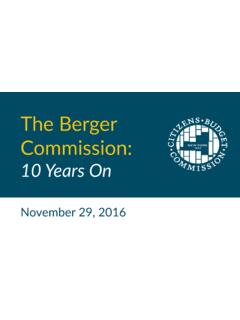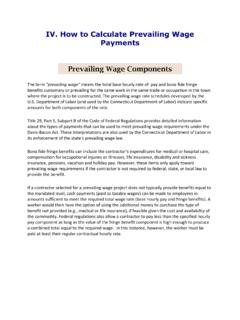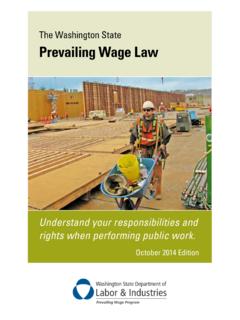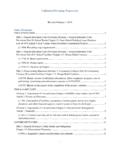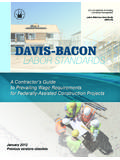Transcription of Things New Yorkers Should Know About PREVAILING WAGE
1 Things New Yorkers Should know About PREVAILING wage February 2012 2 Citizens Budget Commission Two Penn Plaza, Fifth Floor New York, NY 10121 540 Broadway, Fifth Floor Albany, NY 12207 T: 212-279-2605 F: 212-868-4745 Kenneth Gibbs Chairman Carol Kellermann President The Citizens Budget Commission is a nonprofit, nonpartisan civic organization devoted to influencing constructive change in the finances and services of New York State and City governments. This report was researched and written by Maria Doulis, Director of City Studies. Research Assistant Connor Mealey provided assistance collecting data and Carol Kellermann, President, offered editorial guidance.
2 Elizabeth Roistacher, Professor of Economics at Queens College, City University of New York, reviewed the report and provided helpful comments. February 2012 IN T R O D U C T I O N A private contractor awarded a public contract for the construction or maintenance of a public project in New York State is required to pay employees a PREVAILING wage . PREVAILING wage rates are determined for each locality and differ according to occupation, title, and other factors. The requirement to pay PREVAILING wages to laborers, mechanics and other workers on public projects is set forth in the New York State Constitution.
3 New York State Labor Law also mandates PREVAILING wages for all building service workers. The State Department of Labor establishes PREVAILING wages for most localities, but in New York City, they are determined by the City s Office of the Comptroller. The standard for the PREVAILING wage for an occupation is the wage level set by the relevant local collective bargaining agreement with at least 30 percent of trade union membership in each jurisdiction. But the process for determining PREVAILING wage is neither straight-forward nor transparent; little information exists in the public record About how titles are determined or which collective bargaining agreements are used as the basis for mandating wages.
4 Proponents of PREVAILING wage argue it assures a decent quality of life for workers and a high quality of construction and services in government-owned facilities. Opponents say it drives up the cost of construction and makes many projects Several legislative initiatives have been advanced at the State and City level to extend PREVAILING wage requirements to public utilities, construction of affordable housing projects receiving 421-a tax exemptions and to private projects that receive government subsidies. This report is intended to provide New Yorkers with an understanding of how PREVAILING wage law works so they can understand and evaluate the arguments in the current debate.
5 1 For example, a recent report found PREVAILING wage mandates increased the cost of housing construction by 25 percent with no evidence of improved quality. The report used union wages as a proxy for PREVAILING wage rates. See Elizabeth Roistacher, Jerilyn Perine and Harold Schultz, PREVAILING Wisdom: The Potential Impact of PREVAILING Wages on Affordable Housing, a report on behalf of the Citizens Housing and Planning Council, December 2008. 3 PR E V A I L I N G W A G E I S D IF F E R E N T F R O M M I N I M U M W A G E A N D L I V I N G W A G E.
6 The most common form of government regulation of wages is the requirement that employers abide by a minimum wage that is the lowest possible rate of compensation an employee may be paid legally. The minimum wage set by the federal government is currently $ an State governments may establish a higher minimum wage , but New York State has not as of this writing. For a forty-hour work week, a minimum wage worker earns About $15,000 a year. Critics of the minimum wage assert it is too low to meet basic living expenses. This has led some localities, including New York City, to adopt living wage requirements for their own employees and/or contractors.
7 In New York City, the living wage is $10 an hour plus $ in health benefits,3 and it applies to home health care, child care and other caregivers who are employed through contracts funded by New York City. Proposals have been made to set living wage requirements for jobs created by publicly subsidized projects, but no such extensions of living wage have been adopted. PREVAILING wage , in contrast, elevates the standard of wages and benefits paid to the level of compensation received by similar workers in a given area. PREVAILING wage standards were originally adopted by the federal government and many states to ensure that contractors did not win contracts awarded on the basis of the lowest bid by undercutting wages and compromising safe labor practices.
8 Unlike minimum wage , which is uniform in each state, and living wage , which is set at a standard level for applicable projects or occupations, PREVAILING wage is set differentially for specific job titles and occupations in each locality. PR E V A I L I N G W A G E C O V E RS P R I V A T E E M P L O Y E E S T HA T W O R K O N P R O J E C T S W I T H A P U B L I C P U R P O S E. PREVAILING wage laws apply to employees of private companies contracted to work on the construction or maintenance of a public In New York State, public works are not statutorily defined, but the State Department of Labor specifies two conditions that must be met for a project to be considered a public work.
9 First, a public agency must be the contracting entity; this includes construction or building contracts in which a third party acts on behalf of the public entity. For example, PREVAILING wage requirements currently do not apply to private construction projects that receive financial assistance from industrial development authorities (IDAs); however, PREVAILING wages must be paid for work performed for IDAs themselves, as IDAs are considered public 2 There are some exceptions. For example, the rate may be lower for service employees who work with tips and whose total compensation is expected to exceed $ when tips are included.
10 See New York State Department of Labor, Wages and Hours, accessed August 31, 2011, #1. 3 As of July 1, 2006 under New York City Administrative Code Section 6-109 b(1)b. 4 Approximately 10,000 public employees of the City of New York, the New York City Housing Authority, the New York City Health and Hospitals Corporation and the City University of New York are also covered under PREVAILING wage statutes. 5 For more information, see New York State Department of Labor, Public Work General Information: Frequently Asked Questions, accessed August 16, 2011, #0. 4 Second, the project s primary purpose must be to benefit the public.
